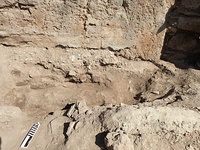| Collection: | Corinth | |
| Type: | Basket | |
| Name: | Temple E, Southeast, context 623 | |
| Area: | Temple E, Southeast | |
| Title: | Grave fill | |
| Category: | Deposit | |
| Notebook: | 1109 | |
| Context: | 623 | |
| Date: | 2015/04/24 | |
| Stratum: | 10%; bones, plaster, lime. | |
| Description: | The soil color is light reddish brown. The soil compaction is firm. The soil is moderately sorted. It is sandy silt. | |
| Notes: | The grave fill contains less pottery and tile fragments than no. 592, the amount of bone fragments is about the same: most are very small frgts and laid without any order. They may come from other burials or this burial, but so far there's no trace of the whole skeleton. In the western end is a curved tile facing up, it was located below the vertical tiles and probably served as a pillow for the skull. The soil of the fill is much harder than in no. 592, contains many reddish and white inclusions. Also small pebbles and marble chips are often present; so is plaster (painted, mostly with white). Overall the inclusions form about 10% of this fill - they are much scarcer than in no. 592. Upon reaching the grave floor, no skeleton has been found - there were few human bones in the younger layers and animal bones in every fill, although in the grave fill itself in lesser numbers. In the western part, where the head would have been, was a sheep hipbone near a large boulder. The human bones are likely related to other burials in Room 4. This grave conjures more questions than answers - the coffin was undisturbed, laid in position to conceal the corpse, yet no body was found. It may be a symbolic burial (cenotaph): they are common in cases of soldiers who died battling in a far away lands and whose families built at least a cenotaph back home. Since this grave is child-sized, the child could have died at the sea (possibly in a shipwreck), or in the mountains; in both cases it's nearly impossible to retrieve the body for a proper burial. Or the child could have been the victim of a highly contagious illness (plague?), in which case cremation would be the safer option for the community. I do not dare explore possible religious reasons to explain the absence of a corpse. A mock child burial can be considered exceptional. Since in medieval times were child casualties common, the common folk would most likely not put the effort and money into building a cenotaph for a 3 year old. In relationship to this area, which was quite wealthy during the Frankish period (judged by pottery and other material remains), the inhabitants were probably wealthy enough to give a symbolic grave even to a small child, with grave structure and painted plaster (coffin decoration?) and all. Since the priorities of commoners and the wealthy are different, a fact visible even in our own society, this interpretation in the context of the Frankish area makes sense. Excavated by A. Lorenzova. 02/06/2015 (L Kennedy): Animal bones: land snail, terrestrial very fragmentary, 0.13 kg, all thrown. Human: Maxillary R Molar (probably M2, in occlusion, with wear facets, apex of roots not fully closed), Maxillary L I2, development complete, wear facets small, and one distal phalanx | |
| Context Pottery: | Fineware. pre-roman2 bodysherds. ; Fineware. ; Fineware. pre-medieval2 bodysherds. ; Fineware. slipped plain glazed (1100-1300), pitcher. 1 bodysherd. | |
| Pottery Summary: | 6 frag(s) 0.004 kg. (0% saved) fineware. | |
| 61 frag(s) 0.5 kg. (0% saved) coarseware. | ||
| 11 frag(s) 0.1 kg. (0% saved) cooking ware. | ||
| Context Artifacts: | tile 1; iron nail square shank 1; bone 1; glass clear green bs 2; plaster white 26; white marble tessera 1, W. 0.008 | |
| Period: | Frankish (1210-1458 AD) | |
| Chronology: | mid 13th century | |
| Grid: | 117.1-116.01E, 1070.95-1070.95N | |
| XMin: | 116.01 | |
| XMax: | 117.1 | |
| YMin: | 1070.95 | |
| YMax: | 1070.95 | |
| Site: | Corinth | |
| City: | Ancient Corinth | |
| Country: | Greece | |
| Masl: | 84.31-84.53m. | |
| References: | Images (4) |
|


